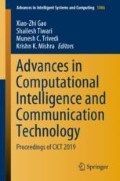Abstract
Even though human–computer interface (HCI) applications such as computer-aided tutoring, learning and medical assistance have brought much changes in human lifestyle. This work has mainly focused on comparison of performance of five commonly used classifiers on emotion recognition. Since features are usually high-dimensional and structurally complex, the efficient classification has become more challenging particularly on low-cost processor and mobile (Android) environment. In this work, five machine-learning algorithms are implemented for speaker-independent emotion recognition and their performance is compared: (a) Logistic regression (LR), (b) K-nearest neighbour (KNN), (c) Naive Bayesian classifier (B), (d) Support vector machine (SVM), and (e) Multilayer perceptron (MLP) of neural network. The feature extraction techniques used to obtain features from speech are (a) Mel-scaled power spectrum; (b) Mel frequency cepstral coefficients. Naive Bayes classifier shows best results in speech emotion classification among other classifiers. Emotion data of happy and sad is taken from Surrey Audio-Visual Expressed Emotion (SAVEE) database.
Access this chapter
Tax calculation will be finalised at checkout
Purchases are for personal use only
References
A. Chavhan, S. Dahe, S. Chibhade, A neural network approach for real time emotion recognition. IJARCCE 4(3), 259–263 (2015)
C. Cameron, K. Lindquist, K. Gray, A constructionist review of morality and emotions: no evidence for specific links between moral content and discrete emotions. Pers. Soc. Psychol. Rev. 19(4), 371–394 (2015)
J. Fredes, J. Novoa, S. King, R.M. Stern, N.B. Yoma, Locally normalized filter banks applied to deep neural-network-based robust speech recognition. IEEE Signal Process. Lett. 24(4), 377–381 (2017)
S. Ramamohan, S. Dandpat, Sinusoidal model based analysis and classification of stressed speech. IEEE Trans. Speech Audio Process. 14(3), 737–746 (2006)
S. Shukla, S.R.M. Prasanna, S. Dandapat, Stressed speech processing: human vs automatic in non-professional speaker scenario, in National Conference on Communications (2011), pp. 1–5
Y.D. Chavhan, B.S. Yelure, K.N. Tayade, Speech emotion recognition using RBF kernel of LIBSVM, in 2nd International Conference on Electronics and Communication Systems (2015), pp. 1132–1135
V. Sucharita, S. Jyothi, V. Rao, Comparison of machine learning algorithms for classification of Penaeid prawn species, in 3rd International Conference on Computing for Sustainable Global Development (INDIACom) (IEEE, 2016), pp. 1610–1613
H. Berg, K.T. Hjelmervik, D.H.S. Stender, T.S. Sastad, A comparison of different machine learning algorithms for automatic classification of sonar targets, in OCEANS MTS (IEEE Monterey, 2016), pp. 1–8
H. Fayek, M. Lech, L. Cavedon, Towards real-time Speech Emotion Recognition using deep neural networks, in 9th International Conference on Signal Processing and Communication Systems, Cairns, QLD (2015), pp. 1–5
P. Tiwari, U. Rane, A.D. Darji, Measuring the effect of music therapy on voiced speech signal, in Future Internet Technologies and Trends. ICFITT 2017. Lecture Notes of the Institute for Computer Sciences, Social Informatics and Telecommunications Engineering, vol. 220. (Springer, 2017)
H. Atasoy, Emotion recognition from speech using Fisher’s discriminant analysis and Bayesian classifier, in Signal Processing and Communications Applications Conference (SIU) (IEEE, 2015), pp. 2513–2516
P. Jackson, S. Haq, Surrey Audio-visual Expressed Emotion (SAVEE) Database (University of Surrey, Guildford, UK, 2014)
Author information
Authors and Affiliations
Corresponding author
Editor information
Editors and Affiliations
Rights and permissions
Copyright information
© 2021 Springer Nature Singapore Pte Ltd.
About this paper
Cite this paper
Tiwari, P., Darji, A.D. (2021). Performance Analysis of ML Algorithms on Speech Emotion Recognition. In: Gao, XZ., Tiwari, S., Trivedi, M., Mishra, K. (eds) Advances in Computational Intelligence and Communication Technology. Advances in Intelligent Systems and Computing, vol 1086. Springer, Singapore. https://doi.org/10.1007/978-981-15-1275-9_8
Download citation
DOI: https://doi.org/10.1007/978-981-15-1275-9_8
Published:
Publisher Name: Springer, Singapore
Print ISBN: 978-981-15-1274-2
Online ISBN: 978-981-15-1275-9
eBook Packages: Intelligent Technologies and RoboticsIntelligent Technologies and Robotics (R0)

